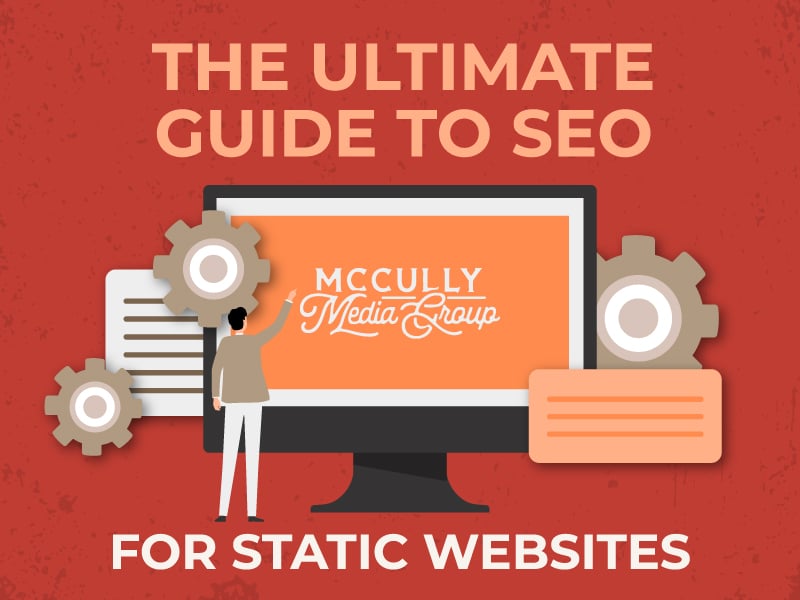There are two types of websites you need to know about: static sites and dynamic sites.
A static website is, well, static. It never changes unless you (or the website’s administrator) edit the site’s code. Your customers can’t add comments, book an appointment, or view personalized recommendations. In fact, they can’t do anything apart from read the page. That differs from dynamic websites, where customers can interact with content.
You might think, “Why should I use static websites, then?” Forget what you heard about the death of static websites. As you ramp up your digital marketing, you’ll see that static sites are sometimes more appropriate than the dynamic type.

What Is a Static Website?
A static website never changes because of the way it’s created. It contains various HTML files, with each file representing a different web page. Because each page is a separate HTML file, a static site renders the same data for everyone who visits it. Another thing to note is that static sites don’t use any server-side scripting language. That means you don’t need to know PHP or ASP.NET to create one of these sites.
A local business might have a static site that displays company history and contact details. This information is unlikely to change.
Dynamic sites, on the other hand, use technologies in addition to HTML, such as PHP and CSS. When a customer visits one of these websites, its server collects information and presents it as a single web page. A dynamic site displays different content whenever someone accesses it. That allows visitors to view personalized content and interact with the website by creating a profile or posting comments.
YouTube is a perfect example of a dynamic website. It presents different video recommendations and playlists depending on the user, their location, and previous interactions with the site.
Benefits of a Static Website for SEO
Although static sites have limitations, there are plenty of situations when you might want to use this style.
Photocredit/Unsplash
Static sites are easy to set up
It’s far easier to set up an HTML-based static website than a dynamic one. That’s because you don’t need extensive coding skills to create these sites. Don’t know PHP? No problem. You can create a basic static site in a few steps with little web development knowledge.
For a really great static site, though, it’s best to work with a website designer. That will help you create a site that reflects your brand, values, and the customers you want to target.
Static websites are safer
Static websites don’t require complicated scripts or databases, meaning they have fewer security vulnerabilities than other website types. That means cybercriminals are less likely to infiltrate your site and steal sensitive information. You might choose a static site if you don’t want to spend a lot of money on website security tools.
Static websites are cheaper
You can save money creating a static website because these sites require less work. It’s that simple. Static websites are also cheaper to maintain because they don’t take up much space on a server. If you’re on a budget, a static site is a better option than a dynamic one.
Search engines love static websites
Because static websites take up less server space and have fewer complicated elements, they load quicker than dynamic sites. Search engines like Google favor fast-loading websites. So you can improve your search rankings and attract more visitors.
Common SEO Challenges for Static Websites
As mentioned above, static websites are great for SEO because they load faster. However, it can take more time to optimize pages for search engines because of this website type’s static nature. Take titles and meta tags. It’s easy to optimize these elements for search on dynamic sites — and make website changes in general. Static sites require more work, such as creating templates for titles and tags and ensuring they work on each page.
The same goes for sitemaps. With static sites, you’ll need to generate these manually, which can take up time and resources. This won’t be a problem if you use a reputable full-service digital marketing agency that does all the hard work for you.
Best Practices for Optimizing Static Websites for SEO
Optimizing a static site for SEO is the same process as optimizing a dynamic one. It just requires more manual work. Here are some tips:
On-page SEO
Before you tinker with your static site’s SEO, invest in an SEO audit. It will evaluate how well your site ranks on search engines and identify any issues that might impact your rankings. Then slowly update URLs, meta descriptions, titles, links, and other on-page elements.
Keywords are also essential. Incorporating relevant keywords into pages can help you rank higher for popular search terms in your industry or location. Don’t just stuff your site with keywords, though. You need to create high-quality content that informs and educates visitors.
Off-page SEO
Off-page SEO refers to all the factors that impact your search rankings outside your static site. These factors include backlinks to your pages and branded searches.
One of the best ways to improve off-page SEO is by working on your social media profiles. Social media doesn’t directly impact search positions. However, sharing links to your site on websites like Facebook and Twitter will drive more people to your pages. Increased traffic makes your site more attractive to search engines.
Measuring SEO Success for Static Websites
Measuring your static site’s SEO is critical. It helps you determine which elements of your website are the most successful for increasing search rankings. For example, you can tell which keywords help you rank for popular search queries.
You should measure your SEO campaigns over time. Various tools help you achieve this goal, such as Google Analytics. You might want to use more advanced business intelligence tools to deep dive into your SEO data. You can then share insights with team members.
Technical Considerations for SEO on Static Websites
There’s more to search engine optimization than on-page and off-page SEO. So don’t forget to work on the technical aspects of your static site. That means creating a sitemap so search engines can crawl and index your website. You will also need to fix any errors that might prevent you from scoring a high position on results pages.
One of the most essential elements of technical SEO is ensuring your site is mobile-friendly. Make sure your site displays on smartphones and tablets! You’ll also want to include keywords in image alt-text.
Final Word
A static website is one that never changes, presenting the same information to everyone who accesses it. That’s because it’s based solely on HTML and doesn’t use any server-side scripting language. Static sites load faster, making them incredibly valuable for SEO. However, there are unique considerations and challenges you need to consider when optimizing these sites.
Measuring the impact of SEO on your static site proves useful. It determines whether you are using the right strategies to improve search rankings.
Working with a full-service marketing agency can help you create a killer static website and solve the challenges of optimizing your site. Schedule a consultation with McCulley Media Group to learn more!
Learn More:
Essential Elements of a High-Performing Website





